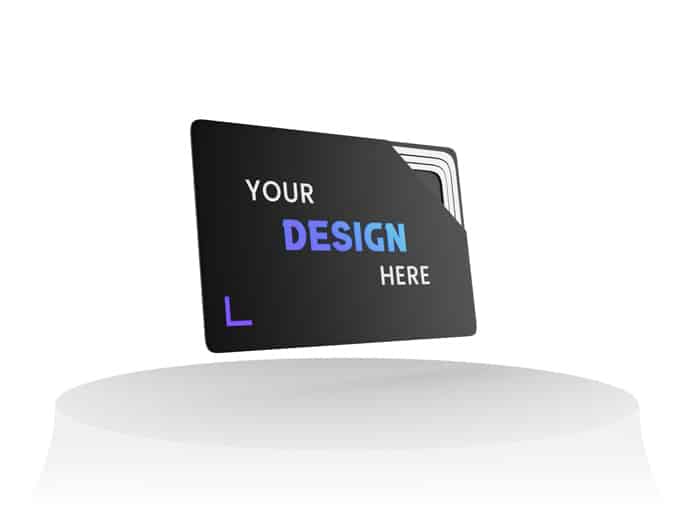
How do you choose the best medium for your business card?

Today’s different media for a professional business card
As you know, the business card is one of the most important marketing tools for any company.
And you can choose between card, plastic, fabric, leather, metal or wood as a support: the choice is immense!
You can also have a digital business card made, featuring only a QR-code and an NFC chip that will allow you to transfer the information you want to your contact, thanks to a wireless connection to their smartphone.
In any case, business cards are an excellent way of introducing yourself and promoting your company to potential customers.
But with so many options available today, it can be tricky to decide what’s best for you.
In any case, it’s important to consider your business and how it will be represented.
This means, for example, that if you’re in the high-tech industry and you present a card with colorful, humorous drawings, you may not come across as very serious.
Conversely, if you’re in the advertising and creative world and your card is in black and white, with the company name, your contact details and a logo, it may not give a very positive image of your services.
The advantage of using these new media – metal, fabric or wood, to name but a few – is that they add a touch of originality while respecting traditional business card codes.
This allows you to stand out from the crowd visually, while still offering the essential information that your interlocutor has a right to expect.
Is it a good idea to distribute business cards in wood, fabric or metal?
Of course, there are no hard and fast rules. However, printing your business cards on original materials such as bamboo, wood bark or metal immediately sets you apart from your competitors: this can be a good thing, especially if you’re in a highly competitive sector.
What’s more, you’re also showing your commitment to protecting the environment, since these natural materials are easy to recycle and don’t generate much pollution during manufacture.
As for fabric, even when reinforced, it seems difficult to recommend it in the professional world unless you work in the worlds of art or creativity: traditional reflexes are still numerous and fabric risks being perceived as too fanciful, even though it allows for extraordinary variations.
On the other hand, it can be interesting to think about using a medium that is symbolically linked to your activity: for example, if you’re in the timber trade, distributing business cards printed on bark might seem logical and coherent.
If you run a Japanese restaurant, bamboo as a business card medium makes a direct reference to Asian culture: there’s a form of continuity that makes an impact.
If you’re in the contemporary design business, a card made of metal can be an extension of the items or elements you sell: the material, in this case metal, will make it easier for your audience to remember your offer.
The practical side of different media
Weight is a criterion to be taken into account, as is sturdiness: metal is obviously heavier than paper, and it’s rigid, so it’s liable to damage the inside of a pocket.
Wood is much lighter, but obviously more fragile.
In fact, it will be more difficult to transport a large number of business cards printed on metal than on simple cardboard.
And don’t forget the practical aspect for your contact: where will he or she keep your business card? In a wallet, a pocket or directly in his jacket pocket?
The idea is not to put your prospect off, and to ensure that your business card is kept as long as possible.
The digital business card solution is also worth considering, because as well as being extremely practical, it transmits the data you wish to share almost automatically: in this case, there are no longer any questions of durability or conservation.
What finish should I choose for my business card?
In general, you’ll be asked to choose between three finishes widely used in the manufacture of business cards on cardboard or thick paper: matte, satin or gloss.
But you should know that we can also offer you gloss or matte varnishes that can be applied to certain areas of the card only: this is particularly interesting if you want to highlight certain words, an image or a logo.
As for the matte finish, it’s generally considered the most luxurious, as it doesn’t offer the sometimes teaser effect of the gloss finish. On the other hand, you should be aware that the colors will be less vivid: if your card features graphic illustrations or photographs, this is not the finish to choose as a priority.
A gloss finish is relatively flattering, as it enhances contrasts and increases color depth.
On the other hand, because it’s so widespread, it tends to be perceived as more “down-market” than a satin or matte finish.
A satin or even velvety finish is a good compromise between the two, especially as it’s very pleasant to hold: it offers good color and hue fidelity while giving a very qualitative impression.
How long does a business card last?
In concrete terms, plastic business cards are the most resistant over time, especially as they are waterproof.
This is an advantage, for example, at a trade show, where people often offer their interlocutor a coffee or a drink, with the slight risk of spillage or wet marks left on the table.
On the other hand, it is environmentally unpleasant both during manufacture and if you wish to recycle it.
On the other hand, cardboard and thick paper, the traditional supports for business cards, are less durable, but can be easily recycled.
As for wood, it all depends on the thickness of the business card and the type of wood used: you can have fairly flexible models made, and therefore less resistant to tearing or snags, or on the contrary, rigid copies made from hard woods: once again, there’s no absolute answer, as it’s more a question of understanding what your business card will really be used for, and what use will be made of it in the future.
Generally speaking, the right question to ask is whether your contact needs to keep your card for the long term.
Today, there are solutions such as the digital business card equipped with an NFC chip or a QR code, which enable all important data to be transferred very quickly to your customer’s smartphone.
The question of the medium and its durability no longer arises.
Metal cards are of course also highly resistant, but if you want the information to remain visible over the long term, you’d be better off opting for engraving rather than printing: experience shows that, with friction, the characters tend to fade quickly.
Is it easy to recycle PVC or plastic business cards?
Today, we can no longer ignore the problem of paper waste and the possibilities for reprocessing waste.
In fact, more and more professionals are concerned about protecting the environment, and pay particular attention to their choice of communication media, for example.
A business card printed on plastic obviously raises the question: can it be easily recycled?
Unfortunately, the answer is no. Recycling petroleum-based plastic requires a great deal of energy and generates harmful emissions into the atmosphere: in fact, it is likely that in the years to come, plastic will be used less and less, in favor, for example, of plasticized media made from corn.
So, if recycling is an important issue for you, it’s best to opt for materials such as thick paper or cardboard, wood or metal.
Written by Camille BODET
The digital business card is a real ally for professionals wishing to promote their business effectively and instantly. In the...Lire la suite
VKARD is an innovative and effective solution to help all professionals stand out from the crowd and reinforce their brand...Lire la suite
If you prepare properly for a job interview, you'll have every chance of winning over the recruiter and getting the...Lire la suite
LinkedIn is a world-renowned business platform, and for good reason! Thanks to its many networking options, LinkedIn is the tool...Lire la suite
Find out how Leexi AI optimizes the management of videoconferences and business calls, saving time and improving efficiency.
In the professional sphere, it's vital to know how to convey certain strong values in order to stand out and...Lire la suite
Mastering the art of conversation is a real asset! By mastering the subtle art of conversation, you'll be able to...Lire la suite
Are you taking part in a trade event and want to do everything you can to make a good impression?...Lire la suite
CRM (Customer Relationship Management) represents a genuine corporate strategy for managing business contacts. This popular tool for professionals is in...Lire la suite
At a time when the professional world is in a perpetual state of competition, we might wonder what place altruism,...Lire la suite















